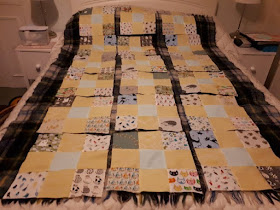We are so privileged to share the lives of these little people. Granddaughter is a real bookworm. She's off to school in August - I do hope her love of books continues. Grandson is a very competent reader but, at our house anyway, he's always too busy doing something else to sit reading.
For example, this is his drawing of a thunderstorm - with, of course, a train and carriages at a level crossing. Yes, they do look a bit like a giant anteater followed by some sheep, but Grandson informed me that it's an electric train, which is that pointy shape. I think that's what he said. He knows much more about such things than I.
Granddaughter is beginning to draw quite well and she drew him a traffic light as a present, and then made it into a card for him, inscribing it carefully with his name and hers. In return, he made her a card with bunnies (she is a bunny fan). We particularly like the different views of the bunnies. All this is very awwww for a granny. (They do have occasional disagreements too, I should add for the sake of accuracy.)
Today we had friends for the day and went to the Scottish National Portrait Gallery, which is a fine building, we think, with lots of fanciful friezes featuring Scottish history.
Now, I've possibly mentioned before that I've been making triangles. Slowly. I looked at various tutorials on the internet but none of them actually mentioned what seemed to me the main problem: that obviously you have to have a seam allowance at the ends of your triangles, or the tips would be cut off when you sew them on to whatever you're joining it to. The ladies demonstrating this show themselves quickly sewing triangles together but then not on to anything else. Of course to anyone with good spatial awareness, it's probably obvious what the answer to the problem is. But I am not that person. After a bit of experimentation with scrap fabrics, however, I realised that if you sew two triangles together, you'll make a seam and then when you turn the triangles back to the right side, the point of the upper triangle will be lower than the seam - leaving a bit of fabric above the point to sew into the next strip - as above (ignore the leftmost point in my photo - I'm coming to that). (I'm sure this isn't a clear explanation, but I could show you easily enough. Should you care.)
But then the demonstrating ladies (do men make patchwork, I wonder?) stop joining their triangles, leaving them looking much like my picture above, and I think to myself - but the leftmost point is at the top of the thing, with no seam allowance to sew in to anything. How is that going to work? And of course the answer is...
that once you put the next ( green chevrony) triangle on, you cover up the original point (as you've been doing all along) and make a new one, thus creating a seam allowance. As any fool would understand. Except me.
I'm sure you either knew this already or have skipped my somewhat inadequate explanation. But surely one of the ladies must have been as dim as me at some point - or must at least have met someone as dim as me - and would have thought to explain, or even better to show, how the magic worked as she went along, instead of just being all airy about it and whizzing around on her machine and saying "and you just continue like that and sew it to the next row bla bla bla."
When you're teaching, you have to make sure that your explanations take account of the possible ignorance of your pupils. I once taught a whole lesson on Norman McCaig's wonderful poem "Toad", covering all the vocabulary, imagery, structure etc that I thought anyone might not have noticed, and then at the end, one student asked me, "But what's a toad?"
Anyway, I'm going to conquer triangles, though they may be slightly wonky... .
Granddaughter said to me the other day, "I had a very clumsy day at nursery today. I knocked my milk over two times. It was very embarrassing."





































